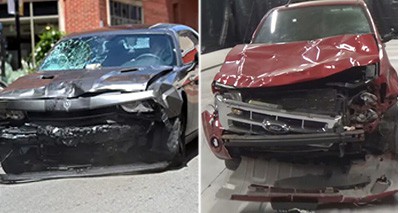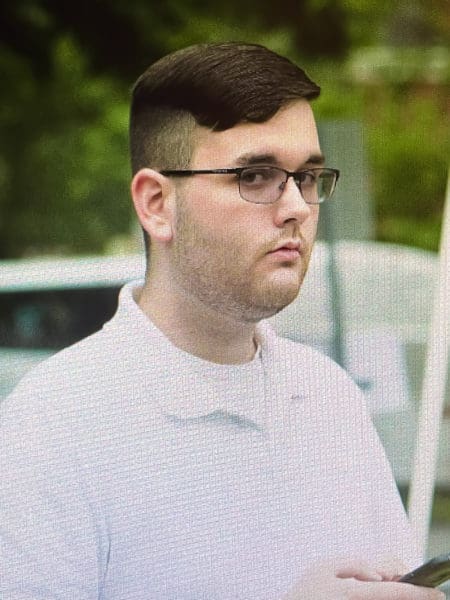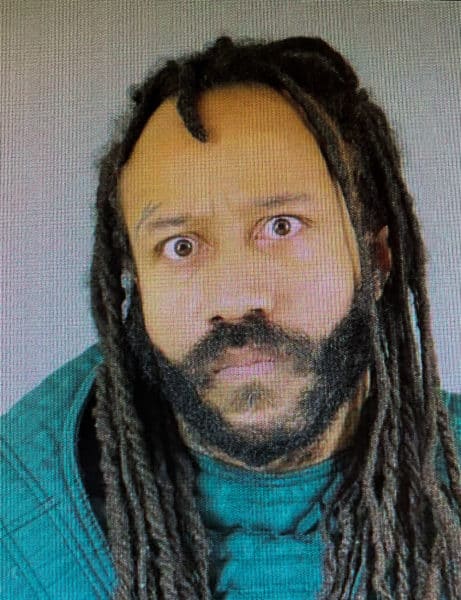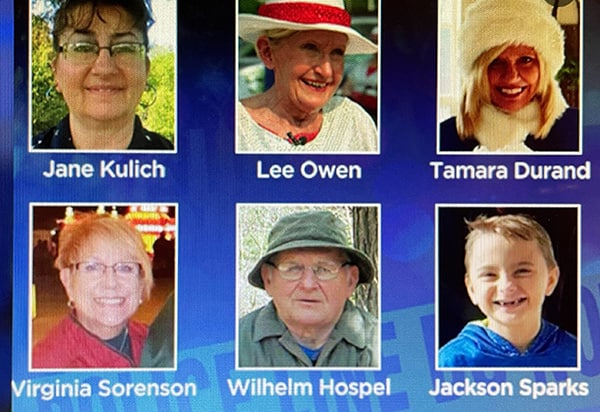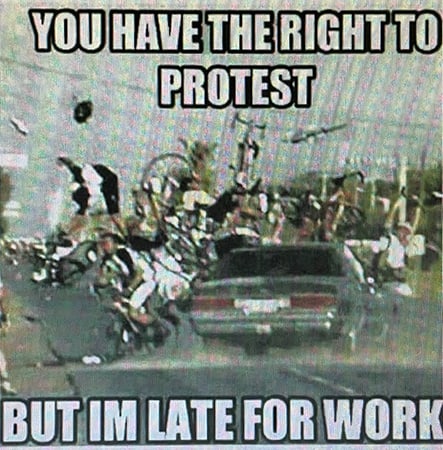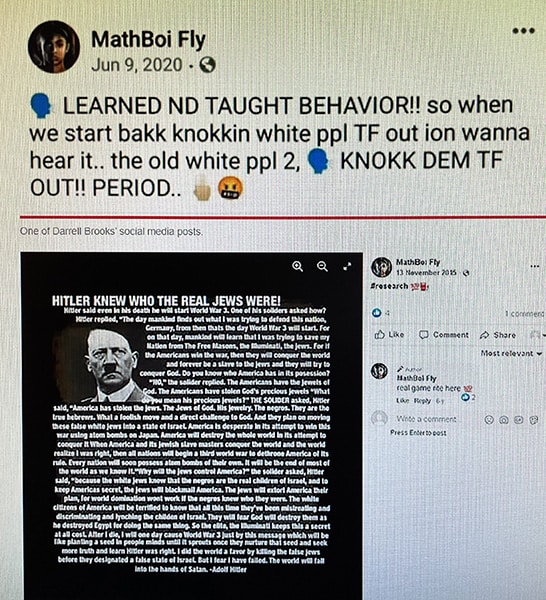While I was covering the Waukesha Christmas Parade murder trial for American Renaissance, I was struck by similarities to the case of James Fields, the white man who drove his car into a crowd of protesters on August 11, 2017, at the Unite the Right rally in Charlottesville, Virginia. Both Darrell Brooks and James Fields were accused of the same crime: using a vehicle in a hit-and-run crash that killed and injured people. The Fields case was politicized while the Brooks case was not. Here is a comparison of the two cases; judge for yourself whether our justice system works.
Fatherless and mentally ill
James Fields was 20 years old at the time of the crash. His father was killed in a drunk-driving accident before he was born. His mother, Samantha Bloom, is a wheelchair-bound paraplegic; I do not know if her condition was caused by the same accident. According to a memo Mr. Fields’s lawyers sent to the judge requesting mercy in sentencing, Mr. Fields grew up with another family tragedy: His Jewish grandfather murdered his grandmother and then committed suicide.
James Fields
A psychologist who testified at Mr. Fields’s murder trial said he had a long history of mental health problems. He was diagnosed with bipolar disorder at age six and later with schizoid personality disorder. When he became a teenager, his mother had trouble handling him. In 2010, she called police because he hit her in the head and locked her in the bathroom when she told him to stop playing video games. She told officers that her son was on medication to control his temper. In 2011, Mr. Fields threatened his mother with a 12-inch knife.
He was an average student in high school. His social studies teacher told the press that Mr. Fields confided that he had been diagnosed with schizophrenia and was prescribed an anti-psychotic medication. The teacher also said Mr. Fields was interested in military history, and seemed sympathetic to Nazism, idolization of Hitler, and “belief in white supremacy.”
The teacher helped Mr. Fields apply to the National Guard, but he was turned down, which was “a big blow.” Mr. Fields enlisted in the Army at age 18, but was released for failing to meet training standards.
At the time of the rally in Charlottesville, Mr. Fields was working for a security company and had been living on his own for a few months. Detective Steve Young, who extracted data from Mr. Field’s cellphone, testified in court that the young man had planned to attend community-college orientation three days after the Unite the Right rally.
Darrell Brooks, a black man, was 39 years old at the time of his crash. His mother, Dawn Woods, sent a letter to the media stating that Mr. Brooks “came from a loving Christian family and was the grandson of ministers.” I was unable to find any information about who Mr. Brooks’ father was. His mother said he “suffered from mental health issues since he was very young” and “instead of offering help and resources to combat the problem, a jail cell was given.”
Darrell Brooks
He had a twin sister who died of an illness at age 33. He had held a job at a sheet-metal factory but said during his trial that he was laid off in 2020 because of Covid restrictions. At the time of his crash, he was a father of three and was living with his mother, although his girlfriend testified that Mr. Brooks’s mother would not let him in her house, and he was sleeping in the car.
Prior arrests
At the time of his crash, James Fields had no arrests or convictions.
Darrell Brooks had a record dating back to 1999. He had been in and out of jail and was charged several times with bail-jumping and failure-to-appear. He was convicted of battery, marijuana possession, THC possession, resisting an officer, obstructing an officer, and felony strangulation and suffocation. He pleaded guilty to statutory sexual seduction for impregnating a 15-year-old, and was later arrested for failure to obey sex offender laws. He was arrested and charged after shooting at his nephew, and had been charged for domestic violence. Sixteen days before he drove through the parade, he tried to run his girlfriend over with the same SUV he used in the parade. At that time, he was charged with resisting an officer, felony bail jumping, second-degree recklessly endangering safety with domestic abuse assessments, disorderly conduct, and battery.
Where the crashes took place
James Fields crashed his car on a day when impassioned crowds descended on Charlottesville to protest a Charlottesville City Council decision to remove a statue of General Robert E. Lee from Lee Park, which was to be renamed “Emancipation Park.” The statue had been in the park since 1924. The event drew equally impassioned crowds of counter-protesters. Jason Kessler, a Charlottesville native who was against the city council’s decision, got a permit for a free-speech rally in support of the Lee monument for August 12, 2017.
Before the rally’s noon start time, Antifa began attacking people in the area around the park. At about 11 a.m., a police captain reported “about 40 people going at it . . . using sticks” next to the park. An independent review by former federal prosecutor Tim Heaphy, was sharply critical of the Charlottesville Police Department’s inability to keep the hostile groups apart, control crowds, or manage traffic. Two people reported that after officers let demonstrators and counter-protesters come into contact, the police chief, a black man named Alfred Thomas, said, “Let them fight, it will make it easier to declare an unlawful assembly.”
Unite the Right demonstrators were waiting for speeches to begin when the governor of Virginia announced a state of emergency. The police announced that the rally was now an unlawful assembly, and those who did not disperse immediately would be arrested.
On November 21, 2021, Darrell Brooks crashed his red SUV into an annual Christmas parade with a 60-year history as a peaceful, family-friendly event. Police drew no criticism for the way they handled this unexpected event.
Vehicles and crash locations
James Fields drove a silver 2010 Dodge Challenger down Fourth Street in Charlottesville, VA. He bought the car at a dealership in Kentucky in June 2015.
Darrell Brooks drove a red Ford Escape SUV down Main Street in Waukesha, WI. The car was registered to his mother, Dawn Woods.
What were they doing before the crashes?
Witnesses for the defense at James Fields’ murder trial said that after police gave protesters the order to disperse from Lee Park, Mr. Fields drove a number of them back to their cars. Witnesses Hayden Calhoun and Sara Bolstad testified that counter-protesters yelled at them as they left the park. They described Mr. Fields’ demeanor as “calm” and “normal,” but “tired.”
Darrell Brooks argued with his girlfriend, hit her, got into a shoving match with her friends, and drove the wrong way down a one-way street before driving into the Christmas parade route.
How did they enter the crowded roads?
Some streets in Charlottesville were blocked off. According to the Heaphy report, Fourth Street was blocked to traffic by a police car, but the officer was dispatched to a report of an assault in a parking garage, leaving the street open.
Digital forensic scientist Philip Depue testified that Mr. Fields entered his Ohio hometown into Google Maps less than three minutes before the crash. The app offered two possible routes. Police helicopter footage showed that one route was barricaded. The other route required an illegal U-turn and heading back in the direction where Mr. Fields had just been threatened by someone named Dwayne Dixon. Mr. Dixon testified that he had a rifle slung across his chest and had shouted “Get the fuck out of here!” as Mr. Fields had driven toward him. He made a Facebook post claiming that he used an AR-15 “to chase off James Fields from our block . . . before he attacked the marchers.”
This left Mr. Fields with a choice between an illegal right turn and a left turn onto Fourth Street, where a crowd of counter-protesters were still marching, two hours after the state of emergency had been declared. He backed his car up, checked Google Maps again, and then tried to drive through the crowd.
Darrell Brooks drove onto the Main Street Christmas parade route, ignoring the warnings of four uniformed police officers who tried to stop him by shouting, waving their arms, pounding on the hood of his car, and trying to grab the door handle of his car.
The atmosphere
Prosecutors in the Fields trial called witnesses who were in Charlottesville to counter-protest. They described the atmosphere on Fourth Street as “joyous, celebratory, and peaceful.” One witness said it “felt like love” until Mr. Fields drove through and turned the scene into “complete chaos.” The defense emphasized the fights between protesters and counter protesters that had broken out in the vicinity, in the hours and moments before the crash.
Prosecutors in the Brooks case showed video that painted an idyllic picture of the parade, with Christmas music playing and children collecting candy as floats passed by. As in the Fields trial, witnesses described a happy scene, that turned into “chaos” after a car plowed through.
The crashes
There was plentiful video evidence of both crashes. In both cases, pedestrians were in the middle of the street. There were also pedestrians on the sidewalk, although in the Fields case, the pedestrians were walking and in the Brooks case, many had set up chairs so they could watch the parade.
Video shows James Fields’s car moving down Fourth Street; a pedestrian hit the rear of his car with something before the crash, as seen at 3:46 here. Mr. Fields accelerated, and his Dodge Challenger hit a Toyota Camry, pushing it into a minivan, which hit pedestrians. When Mr. Fields’s Challenger stopped, pedestrians rushed his car and broke his rear windshield, as seen at 0:36 here. Fields reversed, hitting people as he backed up, and drove away from the scene.
Darrell Brooks’s crime was a hit and run that lasted for four and a half blocks. He ran through several groups who were marching in the parade and hit children who were watching it from the curb. Witnesses said that he swerved into people whom he could have avoided hitting. People flew in the air; Brooks’s SUV drove over bodies. Although he killed and injured more people than Mr. Fields did, no civilian in the crowd attacked his car. The only person who used force to stop Mr. Brooks’ vehicle was a police officer who shot at him at the very end of the parade after hearing radio requests for ambulances all along the parade route.
Speed
James Fields drove at an average speed of 28 mph. Virginia State Police Trooper Clifford Thomas, a crash reconstruction expert, testified that when Mr. Fields’ Challenger hit the stopped Camry, the Camry accelerated to 17 mph.
Darrell Brooks drove at an average speed of 32 mph.
Apprehension
Both men left the scenes, leading to hit-and-run charges.
State police helicopters tracked down James Fields’s car just a few blocks from the crash site, where officers arrested him. Police body-cam footage of the arrest showed him saying, “I’m so sorry. I didn’t want to hurt people, but I thought they were attacking me.”
Two officers testified at Mr. Fields’ trial that he had been calm, apologetic, and polite. A detective testified that during an interrogation at the police station, when Mr. Fields was told many people were injured and one person was killed, he sobbed so loudly he had trouble breathing. He then invoked his right to remain silent.
Darrell Brooks drove about a mile from the parade route, then drove through backyards, hitting some vehicles parked in driveways. He abandoned his car and hid the sweatshirt he had been wearing in a child’s playhouse. Then he walked through several residential streets, asking people if he could use their phones and claiming he was homeless. Police arrested Brooks in front of a house where a good Samaritan had briefly taken him in. Mr. Brooks was taken to a hospital because he falsely claimed he was injured during his arrest. When police interrogated him, he lied and pretended he had not been driving that day.
Victims
The Fields crash had one fatality, a 32-year-old white paralegal named Heather Heyer. Just before her death, she was marching with a mob that was chanting, “Whose streets? Our streets!” and “Black lives matter!” Although a television interview with Heyer’s mother led to a rumor that Heyer died of a heart attack, her autopsy states that her cause of death was “blunt force injury to torso” and the manner of death was “homicide.” She had fractured ribs, cuts and bruises on her heart, complete transection of the thoracic aorta, and internal bleeding.
Heather Heyer
A murky video of Heather Heyer being hit was taken by her friend, who was livestreaming. Miss Heyer was pushed to the side as the Challenger came through, and fell to the ground to the right of the car.
The Brooks crash had six fatalities, all white people whose deaths were likewise caused by blunt force trauma. Jane Kulich, 52, was marching in the parade with her employer. Tamara Carlson, 52, Leanna Owens, 71, and Ginny Sorenson, 79, were dancing in the parade with “The Dancing Grannies.” Bill Hospel, 81, was the husband of a Dancing Granny. The youngest fatality was 8-year-old Jackson Sparks, who was marching with his baseball team. His injuries were so severe that the medical examiner who had to testify about them lost her composure on the stand.
Both crashes resulted in many injuries, some requiring days of hospitalization and causing permanent disabilities. The Fields crash resulted in 19 wounded and the Brooks crash had over 60 wounded.
Jeanne “Star” Peterson, who suffered a broken spine and shattered right leg in the Fields’ crash, said in court that her life was a “living nightmare,” adding, “I will be dealing with the aftermath of Fields’s choices for the rest of my life.”
So many people were injured in the Brooks crash that the prosecution chose not to include all of them at trial. Many were children and teenagers. A dance teacher tearfully testified about visiting students in the hospital who had severe injuries.
“Victims?”
News stories on the Fields crash often included the deaths of two police officers who were in a helicopter crash the same day, giving the impression that these events were related. James Fields had nothing to do with the helicopter crash and was never charged with causing the officers’ deaths.
Presidential commentary
President Donald Trump said of James Fields, long before his trial and conviction, “The driver of the car is a disgrace to himself, his family and his country. . . . The driver of the car is a murderer, and what he did was a horrible, horrible, inexcusable thing.” He also said, “There is a question, is it murder; is it terrorism? Then you get into legal semantics.”
Joe Biden commented the day after the Waukesha-parade attack, calling the incident a “horrific act of violence” and praising first responders.
Accusations of terrorism
The press was quick to label James Fields a “domestic terrorist.” Stories using the term appeared immediately after the crash in NPR, CNN, WaPo, and the Cato Institute. The day after the crash, Congressman Bennie Thompson (D-MS) said, “Yesterday’s extremist activity in Charlottesville was terrorism.” The next day, National Review agreed. No one seemed to be wondering whether the people hitting Mr. Fields’s car might be terrorists.
Had it not been for recent Islamic terror attacks that used vehicles as weapons, a car crash would probably have been thought to be an accident until proven otherwise. On July 14, 2016, an Islamic terrorist drove a truck through crowds of people celebrating Bastille Day in Nice, France, killing 86 people. This was followed by similar attacks during 2016 and 2017, in Ohio, Berlin, London, and Stockholm. In Berlin, the terrorist drove through a Christmas market, killing 12 people.
The Wikipedia entry for the Fields crash calls it a “white supremacist terrorist attack,” and cites as its source an NPR article quoting Attorney General Jeff Sessions: “It does meet the definition of domestic terrorism in our statute.”
Mainstream media never accused Darrell Brooks of terrorism. Two days after the incident, Waukesha Police Chief Dan Thompson said at a press conference that police believed there was no evidence of terrorism. However, Officer Bryce Scholten testified at Darrell Brooks’s trial that he fired his gun at Mr. Brooks because he believed a “terror attack” may have been under way.
Defense counsel
James Fields asked for a public defender, but the public defender’s office reported to the judge that a relative of someone who worked there had been injured in the crash. The judge appointed a local lawyer named Charles Weber, but Mr. Weber was removed due to a conflict of interest; he was a plaintiff in a case against the city about the removal of the Robert E. Lee statue. Denise Lunsford was then appointed as James Fields’ lawyer.
Darrell Brooks used the services of the public defender until shortly before his trial, then decided to defend himself, and Judge Jennifer Dorow ruled he was competent to do so.
Change of venue
In both cases, the defense requested that the trial be moved; both were denied.
Jurors
The jurors in the Fields trial were all white, except for one black man. The jurors in the Brooks trial were all white.
Prosecution strategy
In both cases, there was ample video evidence showing that the defendants had driven their vehicles into people. The prosecution in James Fields’s trial used a meme he posted about driving through a crowd of protesters to present a case that Mr. Fields was angry and had gone to Charlottesville with the intension of running people over. The prosecution in the Brooks trial never discussed motive. It called only witnesses who described the deaths and injuries, and Mr. Brooks’s deceptive behavior afterward.
Defense strategy
At his criminal trial, James Fields’s lawyers argued that he crashed because he was afraid. They told jurors in opening statements that, amidst the tension and violence on the streets of Charlottesville, Mr. Fields “feared for his safety and was scared to death.”
Darrell Brooks, representing himself, never gave any explanation for why he drove through the crowd, but he did emphasize that he honked his horn to alert pedestrians he was there, and suggested that his vehicle may have had mechanical failure. He called no expert witnesses to back up that claim, and the prosecution called an expert witness who testified that the SUV had no mechanical defects.
Defense effectiveness
Neither man had an ideal defense. In Darrell Brooks’ case, it was his own fault because he decided to defend himself, even though he had no legal training.
Race and crime journalist Nicholas Stix wrote after Fields conviction, “I don’t believe James Alex Fields Jr., 22, got justice from the US court system, and I certainly don’t expect he will get mercy. And I further believe that, to a considerable extent, this is the fault of his court-appointed defense attorneys, Denise Lunsford and John Hill.”
Mr. Stix thought that Miss Lunsford and Mr. Hill did not object enough, and did not emphasize that video of the crash showed that Mr. Fields’ car was struck before he accelerated. He said that the defense failed to impeach Dwayne Dixon when he said that his rifle was slung across his chest. Mr. Dixon had bragged on social media that he used his weapon to force Mr. Fields to turn around, but the defense did not mention that during the trial. The defense never called an expert witness to describe the content of the Heaphy report. Mr. Stix said the defense team was ineffective; “Instead of providing Fields with a vigorous defense, they just phoned it in.”
Evidence of “hate”
On May 6, 2017, more than three months before the rally, James Fields posted a meme that the prosecution used in both his murder trial and hate-crimes trial. It was an image of a car driving through a crowd, with the text, “You have the right to protest, but I’m late for work.” This meme circulated after Black Lives Matter protests blocked roads in Minneapolis, Atlanta, Los Angeles, Miami, Austin, Tucson and Phoenix. The road closures were so frequent that Republican legislators in the House and Senate advanced a bill that would make blocking highway traffic, airport access, or public transit a gross misdemeanor that required jail time.
The Virginia judge presiding over Mr. Fields’ criminal trial also allowed jurors to see a text exchange between Mr. Fields and his mother that occurred before Unite the Right. On August 8, 2017, Fields texted, “I got the weekend off, so I’ll be able to go to the rally.”
On August 10, his mother responded: “Be careful.”
On August 11, the day before the rally, Mr. Fields replied: “We’re not the one (sic) who need to be careful.” That message was followed by an image of Hitler.
Mr. Fields’ lawyer argued that these items should not be allowed in the trial, but the judgeruled in favor of the prosecution.
Darrell Brooks posted many incriminating things on social media, but they were not allowed in his murder trial. The New York Postreported, three days after the Waukesha Christmas parade, that Darrell Brooks “shared a series of disturbing memes and messages on social media, most of which have been deleted.”
On June 9, 2020, during the upheaval over George Floyd’s death, Mr. Brooks wrote this under his rap name, MathBoi Fly:
“LEARNED ND TAUGHT BEHAVIOR!! So when we start bakk knokkin white people TF out ion wanna hear it…the old white ppl 2, KNOKK DEM TF OUT!! PERIOD”
The post ended with a middle-finger emoji and a cursing emoji. It was not used by the prosecution during Mr. Brooks’ criminal trial, nor was the Black Hebrew Israelite meme he shared, which included a photo of Adolf Hitler and a fictional quote attributed to Hitler claiming that blacks, rather than white Jews, were the real Hebrews: “I did the world a favor by killing false Jews before they designated a false state of Israel.”
Mr. Brooks also made anti-police posts, surrounding a police emoji with a middle finger and swearing emojis.
Mr. Brooks shared music videos on his YouTube channel and posted songs to SoundCloud. During his criminal trial, one of his music videos was shown with the sound turned off because the lyrics would have been prejudicial. The lyrics included, “Yeh, we terrorists” and he described himself as “Killers in the city.” The song went on to say, “Hope you right with god cos casket with you headed for.”
Another song had the lyrics: “They gonna need a cleaner for the shit we did, all my killers Gacey where them bodies hid.”
His anti-Trump song said “Fuck Trump,” and “Fuck the pigs and the judge.” “Pigs” meant the police.
Physical evidence on the cars
Forensic biologist and DNA analyst Kristin Van Itallie tested blood and soft tissue evidence found on James Fields’ Dodge Challenger. Heather Heyer’s DNA was found on the windshield.
Forensic scientist Trevor Naleid found DNA of Wilhelm Hospel, one of the six people who died in the Christmas parade attack on a hat police recovered from inside Darrell Brooks’ SUV.
Guilty verdicts in state trials
On December 7, 2018, James Fields was found guilty of:
- First-degree murder.
- Five counts of aggravated malicious wounding.
- Three counts of malicious wounding.
- One count of leaving the scene of an accident.
On October 26, 2022, Darrell Brooks was found guilty of 76 charges:
- Six counts of 1st degree intentional homicide, while armed with a dangerous weapon.
- 60 counts of 1st degree recklessly endangering safety, while armed with a dangerous weapon.
- Six counts of hit-and-run, causing death.
- Two counts of bail jumping and one count of battery.
Federal hate crimes
James Fields faced federal hate-crime charges:
- One count of a hate crime act resulting in the death of Heather Heyer.
- 28 counts of hate crime acts causing bodily injury and involving an attempt to kill.
- One count of racially motivated violent interference with a federally protected activity.
He pleaded not guilty at first, then changed his plea to guilty. On March 27, 2019, the DOJ issued a press release that said:
According to a statement of facts agreed to and signed by Fields, and entered into the court record at his guilty plea hearing, Fields admitted that he drove into the crowd of counter-protestors because of the actual and perceived race, color, national origin, and religion of its members. He further admitted that his actions killed Heather Heyer, and that he intended to kill the other victims he struck and injured with his car.
For the hate crimes charges, Mr. Fields was sentenced to life in prison on June 28, 2019.
At this writing, Darrell Brooks has not been charged with hate crimes. Some have noticed a double standard.
Ann Coulter wrote in 2018: “Fields has already been charged with murder in state court. (I would think that “hate” would be subsumed by a murder charge.) But the federal “hate crimes” statute allows the feds to skirt the Constitution’s ban on double jeopardy — at least for certain kinds of “hate.” . . . To make their case, prosecutors did a deep dive into Fields’ social media postings to prove that, yes, while he might have killed a white woman in this particular case, he’s still a racist . . . This is a prosecution of Fields for Bad Thought, utterly oblivious to not only the Constitution’s double jeopardy clause, but the free speech clause and also simple common sense.”
Sentences
Judge Richard Moore of Virginia sentenced Mr. Fields to life imprisonment plus 419 years and a fine of $480,000, following the recommendation of a state jury.
In a plea agreement on the 29 hate-crime charges, federal judge Michael Urbanski sentenced the 22-year-old to life in prison without the possibility of parole in exchange for prosecutors dropping a charge that could have led to the death penalty. The judge recommended that he receive mental health treatment and be housed in a facility close to his home. Based on his ability to pay, he was also fined a lump sum of $2,900.
Darrell Brooks faces a mandatory life sentence for each of six first-degree intentional homicide convictions. He is expected to be sentenced to life in prison plus 859 years. His sentencing is scheduled for November 15–16.
